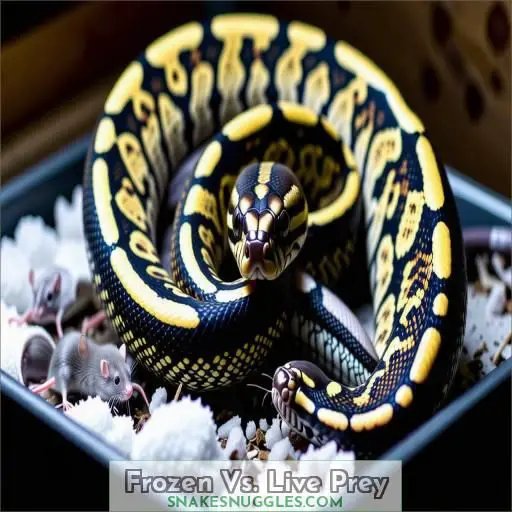
Let’s face it: keeping a ball python healthy means understanding their feeding habits. It’s not just about tossing in a mouse and calling it a day; you need to think about what’s best for your scaly friend. So, grab your favorite cup of coffee or tea, and let’s dive into this discussion about frozen versus live prey. We’ll explore the benefits and challenges of each option, so you can make the best choice for your snake.
Understanding Ball Python Feeding Habits
Ball pythons are natural predators, which means they thrive on a diet that mimics what they would eat in the wild. In their natural habitat, they typically hunt small mammals like rats and mice. When it comes to feeding them in captivity, you want to replicate this as closely as possible. But how do frozen and live prey fit into this picture?
Feeding can be a reflection of your ball python’s instincts. When they strike at prey, whether it’s live or frozen, they’re tapping into those natural hunting instincts. Some owners might worry that frozen prey won’t provide the same stimulation. Here’s the thing: many ball pythons are perfectly happy to accept frozen meals. In fact, some can be more relaxed and less prone to stress when they don’t have to deal with the movement of live prey.
Why Choose Frozen Prey?
Frozen prey is a popular choice for a few reasons. First off, it’s highly convenient. You can buy a batch of frozen rodents and store them in your freezer for weeks—or even months. This way, you’re always ready when it’s feeding time. No need to worry about sourcing live prey, which can be tricky depending on your location.
Another benefit is safety. Feeding live prey can sometimes lead to injuries for your snake. If the prey gets scared or fights back, it could bite your python, potentially causing serious harm. With frozen prey, those risks are eliminated. Plus, it’s easier to ensure the prey is disease-free, giving you peace of mind.
The Case for Live Prey
On the other hand, there are proponents of feeding live prey who argue it’s more natural and stimulating for the snake. Watching your ball python hunt down its meal can be a fascinating experience—like watching nature documentaries right in your living room! This active hunting behavior can also encourage a more engaged and active lifestyle for your snake.
However, it’s essential to handle live feeding with care. You’ll want to supervise the feeding to ensure everything goes smoothly. Also, not every ball python will take to live prey right away. Some might be hesitant or scared, leading to stress for both the snake and the owner.
Potential Risks of Live Feeding
While there are benefits to feeding live prey, it comes with its own set of risks. As mentioned earlier, there’s the possibility of injury. Additionally, live prey can be unpredictable. If the rodent manages to escape in your home, it could lead to problems—or worse, it might cause your ball python to refuse food altogether after a stressful encounter.
Another factor to consider is the ethical side of feeding live prey. Many snake owners are concerned about the well-being of the animals they feed. It’s essential to think not just about your ball python’s needs but also about the mice or rats. It can be more humane to use pre-killed or frozen options.
How to Prepare Frozen Prey
If you decide to go the frozen route, it’s crucial to prepare it correctly. Here’s a step-by-step guide to get it right:
- Thawing: Always thaw frozen prey in the refrigerator overnight. This method is safe and ensures the rodent is properly warmed.
- Heating: Once thawed, you can warm it up further by placing it in a sealed plastic bag and submerging it in warm water. Just make sure it’s not too hot!
- Feeding: Offer the thawed prey to your python using tongs. This helps prevent accidental bites and keeps your hands safe.
By following these steps, you can ensure that your ball python gets a meal that’s just the right temperature and safe to eat.
How to Feed Live Prey
Feeding live prey isn’t as simple as just tossing in a mouse. Here’s a quick guide:
- Set the Scene: Before introducing the prey, ensure your ball python is in a secure environment. A quiet, comfortable space makes for a better feeding experience.
- Supervise: Always watch the feeding session. If the prey seems to be causing your snake distress or if it’s not attacking, remove the prey to avoid any harm.
- Frequency: Feed your ball python live prey only occasionally. Too much of it might lead to bad feeding habits or risk injuries to your snake.
Live feeding can be thrilling, but it definitely requires more attention and care.
What Works Best for Your Python?
Ultimately, the choice between frozen and live prey really depends on your ball python’s preferences and your comfort level as a pet owner. If your snake shows a strong preference for one over the other, it’s wise to follow that lead—after all, happy snakes often lead to happy owners!
You might also find that some ball pythons switch easily between both options. Others might become picky, which can be frustrating. If you notice your snake refusing food, it might be time to reassess its feeding routine and consider changing prey types.
Deciding between frozen and live prey for your ball python involves weighing convenience, safety, and your snake’s well-being. Both options come with their unique benefits and challenges. Frozen prey is generally safer and easier to manage, while live prey might provide a more natural experience for your snake.
In the end, whether you choose frozen or live, the goal is to keep your ball python healthy and happy. Whatever route you take, just remember to pay attention to your snake’s needs and preferences. With a little bit of care and understanding, you can create a feeding routine that works beautifully for both of you.

